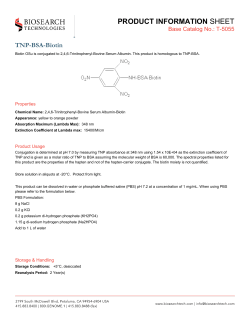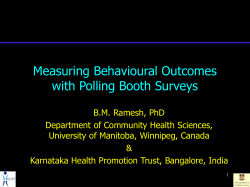
Heterovalent Cation Substitutional and Interstitial Doping
Heterovalent Cation Substitutional and Interstitial Doping in Semiconductor Sensitizers for Quantum Dot Cosensitized Solar Cell Ningning Zhang, Xiaoping Zou, and Yanyan Gao Beijing Key Laboratory for Sensor, Ministry-of-Education Key Laboratory for Modern Measurement and Control Technology and School of Applied Sciences, Beijing Information Science and Technology University, Jianxiangqiao Campus, Beijing 100101, P. R. China Correspondence should be addressed to Xiaoping Zou; xpzou2005@gmail.com Abstract Doped films of TiO 2 /PbS/CdS have been prepared by successive ionic layer adsorption and reaction (SILAR) method. Bi- and Ag-doped PbS quantum dots (QDs) were produced by admixing Bi3+ or Ag+ during deposition and the existing forms of doping elements in PbS QDs were analyzed. The results show that, Bi3+ entered the cube space of PbS, as the donor yielding interstitial doping Bi-doped-PbS QDs, while Ag+ replaced Pb2+ of PbS as the acceptor, yielding substitutional doping Ag-dopedPbS QDs. The novel Bi-doped-PbS/CdS and Ag-doped- PbS/CdS quantum dot cosensitized solar cell (QDCSCs) were fabricated and power conversion efficiency (PCE) of 2.4% and 2.2% were achieved respectively under full sun illumination. Keywords: cation; doping; quantum dot cosensitized solar cell 1. Intruduction Growing attention has been paid to quantum dots for their remarkable characteristics of high absorption coefficient, tunable band gap and multiple exciton generation (MEG) effect [1-4] . In theory, the PCE of QDSSCs could reach 66% [5] , however, the actual PCE of QDSSC is not ideal at present. Introducing impurity into QD sensitizer can successfully improve the performance of QDSSC [6-9] . Using this method, co-sensitized TiO 2 electrode with CdSe and Mg-doped CdSe QDs displayed a broad spectral response [6] and Mn-doped CdS created electronic states in the midgap region of the CdS QD [7], while they did not give the existing form of doping elements. Jin-Wook Lee group reported a PbS:Hg QD-sensitized solar cell with an unprecedentedly high J SC of 30 mA/cm2 , owing to reinforcing Pb-S bond via incorporation of Hg2+ ion into the interstitial site of PbS lattice and broadening the absorption spectrum[8] and encouraging power conversion efficiency has been achieved on such devices. Gerasimos Konstantatos1 et al. reported that PbS, which is a p-type semiconductor, transformed into n-type semiconductor after Bi-doping and then combined the two layers into a homojunction device operating as a solar cell robustly under ambient air conditions with power conversion efficiency of 2.7%. For semiconductor nanocrystals (NCs), a single dopant entered into NCs introduces impurity levels[10].In the case of multiple impurities in a single dot,the nature of delocalization and interaction of the impurity charge carriers may be greatly modified relative to the bulk case [11] . The effects of doping on QDs are akin to the influence of impurity on NCs, because QDs have a strong confinement effect. In this report, Bi3+ and Ag+ were heavily deoped into PbS QD and created impurity energy band in the dand gap of PbS QD. Herein, Bi- and Ag-doped PbS quantum dot (QD) were produced with SILAR method and the existing forms of the doping element in PbS QD were analyzed. Optical measurements, Hall measurement, XPS coupled with theoretical analysis showed that Bi3+ entered the cube space of PbS as the donor, yielding interstitial doping Bi-doped-PbS QDs, while Ag+ replaced Pb2+ of PbS as the acceptor, yielding substitutional doping Ag-doped-PbS QDs. The novel quantum dot cosensitized solar cell (QDCSC) with a photoanode of TiO 2 -Bi-doped-PbS/CdS or TiO 2 /Ag-doped-PbS/ CdS, Cu2 S counter electrode and sulfide/polysulfide electrolyte was fabricated and power conversion efficiency (PCE) of 2.4% and 2.2% were achieved respectively under full sun illumination, which were higher than undoped TiO2 / PbS/CdS. Through the Uv-Vis and UPS measurements, we noted that the changes in energy band of QD leads to the differences in the performance of the QDCSC. The research has a great importance on the development of QDSSC. 2. Materials and Methods 2.1 Sensitization of QD on mesoporous TiO2 film. First, FTO-coated glass substrates were cleaned by ultrasonication in an alkaline, aqueous washing solution, rinsed with deionized water, ethanol and acetone, and dried with nitrogen. The substrates were treated in an 0.04 M aqueous solution of TiCl4 for 30 min at 70ºC, rinsed with deionized water and dried at 450ºC for 30 min. After cooling to room temperature (25ºC), the mesoporous TiO 2 layer composed of 20-nm-sized particles was deposited on substrates by using doctor-blade method and annealed at 450ºC for 30 min. Successive ionic layer adsorption and reaction (SILAR) method was employed to sensitize TiO2 mesoporous film with QDs. Briefly, mesoporous TiO 2 coated electrode was first dipped in ethanol and deionized water (1:1) solution of 0.1 M Pb(NO 3 )2 for 1 min, followed by dipped in methanol solution of 0.1 M Na2 S for 1 min. Between each dipping, the electrode was thoroughly washed with ethanol or methanol and dried with nitrogen. These processes were defined as one cycle. Then, the TiO 2 substrate electrodes deposited with PbS were successively dipped in ethanol solution of 0.1 M Cd(NO 3 )2 for 5 min and methanol solution of 0.1 M Na2 S for another 5 min. Between each dipping, the electrode was thoroughly washed with ethanol or methanol and dried with nitrogen. For Bi-doped-PbS and Ag-doped-PbS QD, 5 mmol of BiCl3 and 6.7 mmol AgNO 3 was added to Pb(NO 3 )2 cationic precursor solution respectively. To obtain the optimum photovoltaic performance in each condition several coating cycle was repeated (2 cycles for PbS, Bi-doped-PbS and Ag-doped-PbS, 6 cycles for CdS of Ag-doped-PbS/CdS, and 7 cycles for CdS of Bidoped-PbS/CdS ). 2.2 Solar cell fabrication. The polishing brass plate was cleaned by ultrasonication in an alkaline, rinsed with deionized water, ethanol, isopropanol and acetone (volume ratio was 8:2), and dried with nitrogen. The clean brass plate was etched in hydrochloric acid (35.0~37.0%) at 80ºC for 30 min and subsequently washed with deionized water and dried with nitrogen. Polysulfide electrolyte solution composed of 1M Na2 S,1M S and 0.1M NaOH in deionized water was dropped on etched brass for 15-30 min and black colored Cu2 S formed on the brass foil. The QDs sensitized TiO 2 electrode and Cu2 S countere lectrode were assembled using 60 mm thick sealing materials. Polysulfide electrolyte solution was injected into the gap between photoanode and counter electrode from the side using injector. The active area was 0.25 cm2 . 3. Results and discussion Field emission scanning electron microscope (FESEM, Hitachi S-4800) was used to characterize the morphology of the samples. As revealed by SEM images (Fig.1a, b, c, d), a mesoporous films were deposited on FTO glass. By comparing the SEM images of TiO2 /Bi-doped-PbS (Fig.1a) and TiO 2 /Bi-doped-PbS/CdS (Fig.1b), TiO 2 / Ag-doped-PbS (Fig.1c) and TiO2 /Ag-doped-PbS/CdS (Fig.1d), the pore size distribution of mesoporous films decreased after deposited CdS QDs, which confirm that the cosensitized QDs formed. Energy dispersive X-ray spectrum (EDS) was collected to investigate the composition of the mesoporous films. According to the corresponding EDS spectra, the element Bi and Ag exist in the mesoporous films. To further determine and analyse of elements in the mesoporous films, the inductively coupled plasma optical emission spectroscopy (ICP-OES) measurement was used. The results revealed that the element Bi and Ag exist in the corresponding mesoporous films (Table 1), in agreement with the results obtained with EDS. The black, red, blue and green curves in Fig.2a show X-ray powder diffraction spectra measured before and, after the TiO 2 mesoporous film is deposited the pure PbS, Bi-doped-PbS, and Ag-doped-PbS, respectively. For comparison, we find six additional diffraction peaks that do not originate from TiO 2 , suggesting that the PbS crystal growth on the TiO2 mesoporous film. In addition, new diffraction peak do not appearance with Bi-doped-PbS and Ag-doped-PbS, which suggests that no new substance is formed after doping with cation Bi3+ and Ag+. However, a slight broadening of (311) crystal surfaces of Bi-doped-PbS caused by the size change after doping cation Bi3+. According to Fig.2b, Bi-doped-PbS/CdS and Ag-doped-PbS/CdS cosensitized have been successfully deposited on mesoporous TiO 2 films respectively. Figure 1 SEM images of TiO2 /Bi-doped-PbS, TiO2 /Bi-doped-PbS/CdS, TiO2 /Ag- doped-PbS, TiO2 /Ag-doped-PbS/CdS. Inset in images are corresponding EDS spectra. Figure 2 XRD patterns of TiO2 , Bi-doped-PbS, Ag-doped-PbS, Bi-doped-PbS/CdS, Ag-dopedPbS/CdS Table 1 Content of atoms in TiO2/ Bi-doped-PbS and TiO2 / Ag-doped-PbS solid film Sample MP b / % a MBi / % b MCd / % c MS / % MAg / % TiO2 /PbS:Bi/CdS 0.976 0.003 3.249 2.79 -- 0.349 -- 1.379 1.234 0.019 TiO2/ PbS:Ag/CdS a b c d d e e MP b , MBi , MCd , MS, MAg : Mole percent of the atom of Pb, Bi, Cd, S, Ag Figure 3 TEM images of (a)PbS, (b)Bi-doped-PbS, and (c)Ag-doped-PbS QDs. The PbS, Bi-doped-PbS and Ag-doped-PbS QDs sensitized mesoporous TiO 2 films were also characterized with a transmission electron microscope (TEM, FEI, Tecnai F20UT) operating at 200 KV, to investigate impact of doping on PbS QDs. TEM images show very clear lattice fringes from the QDs (Fig.3). It is obviously that the size of Bi-doped-PbS (Fig.3b) QD is smaller than that of PbS QD (Fig.3a), while the size of Bi-doped-PbS QD (Fig.3c) is be equal to that of PbS QD. We infer that Bi impurity causes the lattice contraction of PbS and Ag impurity have no effect on the lattices of PbS, in agreement with the results obtained with XRD. X-ray photoelectron spectroscopy (XPS) analysis of PbS, Bi-doped-PbS, and Ag-doped-PbS QDs adsorbed on mesoporous TiO2 surface were also performed (Fig.4). By analyzing XPS (Table 2) , the valence state of elements S, Pb, Bi, Ag are -2, +2, +3 and +1 ( the relatively stable valence of Ag element is +1 [11] ) respectively. Figure 4 XPS of (a) S 2s peaks, (b) Pb 4f peaks (c) Bi 4f peaks and (d) Ag 3d peaks for PbS, Bi-doped-PbS, and Ag-doped-PbS QDs adsorbed on mesoporous TiO2 surface. Table 2 Valence state parameters of elements in PbS, Bi-doped-PbS and Ag-doped- PbS QDs Element Binding energy Valence state Valence S 160.67 2p -2 Pb 138.32 4f 7 +2 Bi Ag 157.86 367.5 4f 7 3d5 +3 +1,+2 Semiconductor doping is the process that changes an intrinsic semiconductor to an extrinsic semiconductor. Hall measurement suggests that PbS, Bi-doped-PbS, and Ag-doped-PbS are p-type, n-typ and p-type semiconductor (Table 3) respectively. It demonstrates that Bi impurities "donate" their extra valence electrons to conduction band of PbS, providing excess electrons to PbS. Excess electrons increase the electron carrier concentration of PbS, forming impurity energy band which lies closer to the conduction band than the valence band. However, Ag impurities "accept" electrons from the valence band of PbS. Excess holes increase the hole carrier concentration of PbS, forming impurity energy band which lies closer to the valence conduction band than the conduction band. Table 3 Resistivity, Hall coefficient, conductivity type, carrier density and hall mobility of PbS:Hg thin film using hall effect measurement system. The measurement conducted at room temperature under applied field was adjusted from 1 to 5 kG. Hall Field Resistivity [Gs] [ohm∙cm] Coefficient [cm3 /C] Type TiO2 TiO2 /PbS 3000 3000 -3.6201×102 -7.4174×102 -2.34155×106 1.56716×106 TiO2 /PbS:Bi 3000 6.3436×104 TiO2 /PbS:Ag 3000 1.5702×10 Sample 5 Hall Carrier Density [1/cm ] Mobility [cm2 /(V∙s)] n p 2.6692×1012 3.9881×1012 6.4682×103 2.1128×103 -8.08514×103 n 7.7302×1014 1.2745×101 3 P 1.3213×10 4.73004×10 3 15 3.0123×10 2 The diffuse reflection absorption spectra of QDs are shown in Fig. 5a. After doping impurities, a broad band appeared at near infrared region is observed for Bi-dopedPbS and Ag-doped-PbS QD, which can attribute to heavily doped Bi or Ag impurities formed impurity band in the band gap of PbS. For Bi-doped-PbS based on mesoporous TiO 2 film, the optical absorption of Bi-doped-PbS was significantly enhanced in the visible light is obvious, indicating that Bi-doped-PbS can generate more photogenerated electrons. In addition, Bi-doped-PbS QDs show the obvious blue shift in the absorption spectra due to the increase in the bulk energy band gap. In general, the shift of the onset absorption to lower wavelengths with decreasing particle size represents size quantization effects in these particles [12] . For Ag-doped –PbS, there is no obvious change expect for a broad band at near infrared region, suggesting that the size of PbS is unchanged after doping Ag impurities. These results are in agreement with the results obtained with XRD and TEM. Figure 5 (a) Diffuse reflection absorption spectra, (b) the plot calculated by using αhν=A(hν-Eg)2 equation from absorption spectra, (c) UPS spectra of PbS, Bi-doped- PbS, Ag-doped-PbS QDs. Optical band gap of the QDs was estimated from diffuse reflection absorption spectra using αhν=A(hν-Eg)2 equation [13]. As shown in Fig. 5b, the optical band gap of PbS, Bi-doped-PbS, Ag-doped-PbS QD is 1.05eV, 1.2eV, 1.07eV respectively. Ultraviolet photoelectron spectroscopy (UPS) can determine valence band maximum (VBM) [14]. Secondary cut-off is fitted to energy of He I light source (21.2 eV), where extrapolation of low energy region corresponds to potential energy of VBM from the vacuum level [8, 14] (Fig. 5b). The position of conduction band minimum (CBM) is estimated based on VBM and optical band gap energy [8]. Heavily doped Bi- dopedPbS QD is n-type semiconductor, so the impurity band near to CBM (fig.5d), while the impurity band near to VBM of heavily doped Ag-doped-PbS QD because it is p-type semicounductor. Band edge alignment is shown in Fig. 6, where CBMs of the doped QDs move upward relative to pure QDs. Figure 6 Band edge alignment diagram for (a) Bi-doped- PbS and (b) Ag-doped-PbS QDs Fig.7a shows diffuse reflection absorption spectra of QDs cosensitized mesoporous TiO2 films. Photocurrent density-voltage (J-V) curves of the QDCSCs based on TiO2 /PbS(2)/CdS(7), TiO 2 /Bi-doped-PbS(2)/CdS(7), TiO 2 /PbS(2)/CdS(6) and TiO 2 / Ag-doped-PbS(2)/CdS(6) were presented in Fig. 7b. We show the solar cell performance parameters in Table 4. By compared with the corresponding undoped system, J SC of QDCSC is essentially increased after doping Bi or Ag impurities into PbS QDs. The JSC of the cell can be influenced by the value of Monochromatic incident photon-to-electron conversion efficiency (IPCE) and spectral response range. Doping of Bi or Ag impurities into PbS QDs leads to the value of IPCE improved and spectral response range broaden, according to IPCE spectra (Fig. 7c) resulting in J SC increased. Besides, for the two systems, VOC is degraded as photocurrent increase, and this may be because the decreased shunt resistance. The fill factors are degraded which may be due to the VOC degraded. Thus power conversion efficiency is slightly improved through doping Bi or Ag impurities into PbS QDs. The electrochemical impedance spectroscopy (EIS) is shown in Fig. 7d. The series resistances (Rs), the electronic transfer resistances of TiO 2 /QDs and electrolyte interface (Rc), and photocathode and the electrolyte solution interface (Rct) solution interface (Rct) are summarized in Table 5 derived from the spectra by using the equivalent circuit [15]. The Rs and Rc decrease after doping Bi3+ and Ag+, indicating that the charge transfer resistance reduce in doped QDCSCs. However, the decreased Rct values increase the electronic transfer resistances. Thus, the PCE of doped QDCSCs is slightly improved. Figure 7 (a) Diffuse reflection absorption spectra of photoanode, (b) J-V curves, (c) IPCE spectra and (d) EIS spectra of TiO2 /PbS(2)/CdS(7), TiO2 /Bi-doped-PbS(2)/ CdS(7), TiO2 /PbS(2) /CdS(6) and TiO2 /Ag-doped-PbS(2)/CdS QDCSCs . Table 4 Photovoltaic performances extracted from current-voltage measurements of different working electrodes Device a Jsc / mAcm -2 b Voc / V FF c d PCE / % PbS(2)/CdS(7) 13.826±0.126 468.85±0.85 0.353±0.04 2.29±0.05 1-20PbS:Bi(2)/CdS(7) PbS(2)/CdS(6) 16.02±0.1 12.08±0.4 432.57±2.5 461.18±0.9 0.338±0.08 0.318±0.04 2.33±0.04 2.111±0.04 1-150 PbS:Ag(2)/CdS(6) 14.885±0.06 427.510±2.5 0.342±0.01 2.177±0.05 a Jsc: Short-circuit photocurrent density, b Voc: Open-current voltage, c FF: Fill factor, d PCE: e Power conversion efficiency, Rs : Series resistance Table 5 Rs, Rc, and Rct Values of undoped and doped QDCSCs Device PbS(2)/CdS(7) 1-20PbS:Bi(2)/CdS(7) PbS(2)/CdS6) 1-150PbS:Ag(2)/CdS(6) a Rs a(Ω) Rc b (Ω) Rct c(Ω) 23.57 71.08 26.83 22.1 25.86 38.65 165.8 20.3 26.12 16.33 130.7 10.76 b Rs : Series resistances, Rc: Electronic transfer resistances of TiO 2 /QDs and electrolyte c interface, Rct : Electronic transfer resistances of photocathode and the electrolyte solution interface Schematic structure of the PbS, Bi-doped-PbS and Ag-doped-PbS QDs are shown in Fig. 8, according to results of optical measurements, XPS, Hall measurement and reported articles [8, 16]. The radius of Bi3+ is equal to the clearance radius of PbS cubes [16] are shown in Table 6, so the Bi3+ can enter into the cube clearance to form interstitial doping. We infer that the (Pb-S) bonds are reinforced by doping Bi3+, which not only contribute to a decrease of the lattice size but for the increase of the optical band gap of PbS QD. The radius of Ag+ is a little smaller than the clearance radius of PbS cubes and equals to the radius of Pb2+, thus Ag+ can substitute for Pb2+ to form replacement doping, leading to lattice contraction. However, the breaking of (Pb-S) bonds makes lattice expansion. These two kinds of function causes a little lattice distortion and the size of Ag-doped-PbS unchanged. Figure 8 The ball-stick mode of quantum dot unit cells (a)PbS and Bi-doped-PbS and (b)PbS and Ag-doped-PbS Table 6 Size parameters of each material in the PbS lattice [16] PbS lattice Substance Size(Å) Clearance Radius 2+ Radius 3+ Radius + Radius 2- Constant radius (Pb ) (Bi ) (Ag ) (S ) 5.94 ≈﹥1 1.19 1.03 1.15 1.84 Based on optical measurements, UPS and Hall measurement, we inferred the internal mechanism of QDCSCs and doped QDCSCS to explain the changes of performance for QDCSCs after doping. From Fig. 9, the significantly difference in doped QDCSCs is that there is impurity band in doped PbS QDs. The PbS and CdS QDs can both absorb light, leading to the separation of electron-hole. For Bi-doped–PbS QDCSSC, the photogenerated electrons generated from impurity band can be transferred to the CBM of TiO 2 , which means that Bi is donor impurity contributing electrons. For Ag-doped-PbS, the photogenerated electrons generated form CdS not only be transferred to the CBM of TiO 2 but also the Ag impurity band possible, which means that Ag is acceptor impurity contributing holes. This means that there is higher probability recombination of electrons in impurity band leading to the decreased of Rc for doped-PbS QDCSC. Figure 9 Schematic illustrations for internal mechanism of (a) TiO2 /PbS/CdS and TiO2 /Bi-dopedPbS/CdS (b) TiO2 /PbS/CdS and TiO2 /Ag-doped-PbS/CdS QDCSCs 4. Conclusions Heavily doped PbS QDs were prepared by doping cation Bi3+ and Ag+ and the existence form of impurities is doping. The cation Bi3+ entered the cube space of PbS as the donor, yielding interstitial doping Bi-doped-PbS QD, and Ag+ replaced Pb2+ of PbS as the acceptor, yielding substitutional doping Ag-doped-PbS QD. The novel Bi-doped-PbS/CdS and Ag-doped- PbS/CdS QDCSCs were assembled and PCE of 2.4% and 2.2% were obtained respectively under full sun illumination. The analysis of the changes of energy level of the cells is conducive to understand the effect of doping in theory and the development of QDSSCs. Conflict of Interests The authors declare that there is no conflict of interests regarding the publication of this paper. Acknowledgments The authors acknowledge the financial support from the National Natural Science Foundation of China (Grant No. 91233201 and 61376057), the National High-tech R&D Program of China (863, No. 2011AA050527), the Beijing Municipal Natural Science Foundation (Grant No. 3131001), the Scientific Research Project of Beijing Educational Committee (Grant No. KZ201211232040), Beijing National Laboratory for (of) Molecular Sciences (No. BNLMS2012-21), State Key Laboratory of Solid State Microstructures of Nanjing University (No. M27019), State Key Laboratory for New Ceramic and Fine Processing of Tsinghua University (No.KF1210), Key Laboratory for Renewable Energy and Gas Hydrate of Chinese Academy of Sciences (No.y207ka1001), Beijing Key Laboratory for Sensors of BISTU (No.KF20141077207 and KF20141077208) and Beijing Key Laboratory for photoelectrical measurement of BISTU (No.GDKF2013005). References [1] A.J. Nozik, M.C. Beard, J.M. Luther et al., “Semiconductor quantum dots and quantum dot arrays and applications of multiple exciton generation to third- generation photovoltaic solar cells,” Chemical Reviews, 110, 6873–6889, 2010. [2] J.B. Samber, T. Novet, B.A. Parkinson, “Multiple exciton collection in a sensitized photovoltaic system,” Science, 330, 63–66, 2010. [3] P.V. Kamat, “Quantum dot solar cells. Semiconductor nanocrystals as light harvesters,” Journal of physical chemistry, 112, 18737–18753, 2008. [4] J. Tang, K.W. Kemp, S. Hoogland et al., “Colloidal-quantum-dot photovoltaics using atomic- ligand passivation,” Nature Materials, 10, 765–771, 2011. [5] A.J. Nozik, “Quantum dot solar cells, ” Physica E, 14, 115-120, 2002. [6] W. Le, W.-C. Kwak, S.K. Min et al., “Spectral broadening in quantum dots-sensitized photoelectrochemical solar cells based on CdSe and Mg-doped CdSe nanocrystals,” Electrochemistry Communications, 10, 1699–1702, 2008. [7] P.K. Santra and P.V. Kamat, “Mn-doped quantum dot sensitized solar cells: a strategy to boost efficiency over 5%,” Journal of American chemical society, 134, 2508−2511, 2012. [8] J.-W. Lee, D.-Y. Son, T. K. Ahn, H.-W. Shin et al., “Quantum-dot-sensitized solar cell with unprecedentedly high photocurrent,” Scientific reports, 3: 1050 | DOI: 10.1038/srep01050, 2012. [9] A. Stavrinadis, A. K. Rath, F. P. G. de Arquer et al., “Heterovalent cation substitutional doping for quantum dot homojunction solar cells,” Nature communications, 4:2981 | DOI: 10.1038/ncomms3981, 2013. [10] R.A. Abram, G.J. Rees, B.L.H. Wilson, “Heavily doped semiconductors and devices,” Advances in Physics, 27,799-892, 1978. [11] D. Mocatta, G. Cohen, J. Schattner et al., “Heavily doped semiconductor nanocrystal quantum dots,” Science, 332 (77): 77-81, 2011. [12] A. Kongkanand, K. Tvrdy, K. Takechi et al., “Quantum dot solar cells. Tuning photoresponse through sizeand shape control of CdSe- TiO2 architecture,” Journal of American chemical society, 130, 4007-4015, 2008. [13] S. Tsunekawa, Fukuda T, Kasuya A. “Blue shift in ultraviolet absorption spectra of monodisperse CeO2-x nanoparticles,” Joural of applied physics, 87, 13181321, 2007 [14] B. Carlson, K. Leschkies, E.S. Aydil et al., “Valence band alignment at cadmium selenide quantum dot and zinc oxide (1010) interfaces,” Journal of American chemical society, 112, 8419–8423, 2008. [15] M.H. Deng, S.Q. Huang, Q.X. Zhang et al., “Screen-printed Cu2S-based counter electrode for quantum-dot-sensitized solar cell,” Chemistry Letters, 39(11): 11681170, 2010. [16] Shannon, R.D. “Revised effective ionic radii and systematic studies o interatomic distances in halides and chalcogenides,” Acta. Cryst. A., 32: 751–767,1976.
© Copyright 2025









